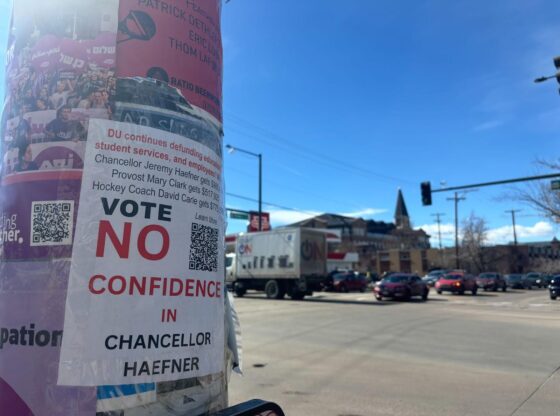DU is in our fourth quarter of Zoom University. At this point, every college student has taken more than their fair share of online classes, ranging in format from hyflex and hybrid to synchronous and asynchronous.
While asynchronous classes can utilize external resources, they do not offer the same level of interaction with peers or professors. The lack of professor engagement is a problem for many students, especially those who learn best through discussion or lectures.
Kasey Desmond, a senior geography student, was frustrated by the lack of engagement from her professors online.
“What I perceive as higher levels of apathy from professors has really turned me off from putting more of myself into school and these courses. It makes me less motivated and interested,” Desmond said.
Asynchronous classes can feel isolating. The lack of a shared space, physical or virtual, makes the class feel separated. At least in synchronous classes, students know that they are not learning by themselves.
This sense of disconnect from one’s classes is often exacerbated by a lack of up-to-date material. Serina Chavez, a junior sociology major, said her professor’s obvious reuse of materials from the summer quarter made the class “feel even more disconnected. If [the professor] is actually recording the lectures during this time, they can customize them a little more for each individual class.”
Dr. Rachael Liberman, an MFJS professor at DU, pointed out that it can make sense to keep applicable material from quarter to quarter. However, she stressed the importance of adapting material to an online setting.
“[To do online classes] in a way that is engaging and meaningful, you need to create opportunities to use resources. You need to say, ‘Okay, we are going to use the internet, videos, and what we can to create a learning environment. We are not going to try to recreate the physical classroom, because that’s impossible,’” Liberman said.
Unfortunately, in my own experience and in the experiences of many students I interviewed, numerous professors do not strive to have an engaging Zoom class. Scattering Canvas posts of PowerPoint presentations that are 40% photos and assigning textbook chapters without written or oral context does not create an engaging learning environment. It encourages apathy and rote memorization.
Dr. Richard Colby, a DU writing professor, pointed out that many professors see online teaching as a temporary one-to-two-year change and are simply hanging on until they can go back to what they are used to. In contrast to those professors, Colby said he actually prefers the asynchronous modality. He likes that it “encourages students to develop soft skills that they might not have had before, like self-awareness and project management.”
Both Liberman and Colby agreed that asynchronous learning can be extremely tough on students who thrive on structure and learn by interacting directly with peers and professors.
But while Colby sees this as a learning opportunity for students, Liberman sees it as an inherent problem with the asynchronous modality. “It became clear to my students, and to me, that for the particular courses I was teaching, the synchronous modality would work better. The real-time interactive element was not there in the asynchronous modality. I connected, but I did not feel that it was a strong [connection],” Liberman said.
Students seemed to agree with her. All six students I interviewed said that they got less from asynchronous courses than from synchronous Zoom classes or in-person classes. Low retention of course material was a common trend.
Ailis Shankroot—a sophomore psychology and Spanish double major—said, “In terms of long-term retention, I got a lot less out of [asynchronous classes]. Maybe I knew the material at the moment, but because there was no in-person interaction to associate it with, all of it left my brain as soon as I finished.” When I asked if she thought she was getting the same quality of education from asynchronous classes as synchronous or in-person classes, she responded, “Not at all.”
On the overall difference in quality, Chavez said, “I think with asynchronous classes, it’s a decrease in quality because DU sells a specific classroom environment to students. Small classrooms, close relationships with your professors and peers, and heavy discussion—that is not applicable online with the asynchronous modality.”
Specialized classroom environments centered on high professor engagement is a major draw for students who are looking to attend DU. For many, it helps justify the high tuition. But if students are clearly not receiving that same standard of education, should they still have to pay the same base credit rate?
Desmond does not think so. “In my experience, there is no way that all of these different learning styles are on the same level of quality. Looking at myself as a consumer, I am receiving less for the same amount of money.”
This sentiment was echoed by other students. Skyler Wilkey, a second-year international studies and public policy double major, thought that “nothing about Zoom classes compares to in-person classes, not even a little bit. I cannot see why I would have to pay the same amount.”
Liberman pointed out that, when DU made the decision last spring to continue to charge the same in-person tuition, they did have some plausible deniability in assuming that asynchronous classes could be just as effective as in-person ones. “Before, when we pivoted in Spring 2020, we did not know whether or not students would do well or thrive in that [online] environment. But now we know that some don’t based on feedback.”
Even Dr. Colby acknowledged that asynchronous classes can be a toss-up, calling them “hit or miss.” However, he was against lowering the cost, saying, “the question becomes: what is the DU education and curriculum worth to you?”
To me, the DU education is valuable. I have enjoyed most of my classes here. Small class size, a focus on discussion and high peer and professor engagement have a lot to do with that. However, that “DU standard” is not upheld throughout asynchronous classes.
Asynchronous classes can be beneficial if done right. But too often, they result in low commitment from both students and professors, becoming perfunctory instead of instructive. Without standards to ensure high quality and with clear feedback that asynchronous learning does not stimulate students as much as in-person classes do, DU has no basis for charging the same credit rates for in-person and asynchronous classes.











